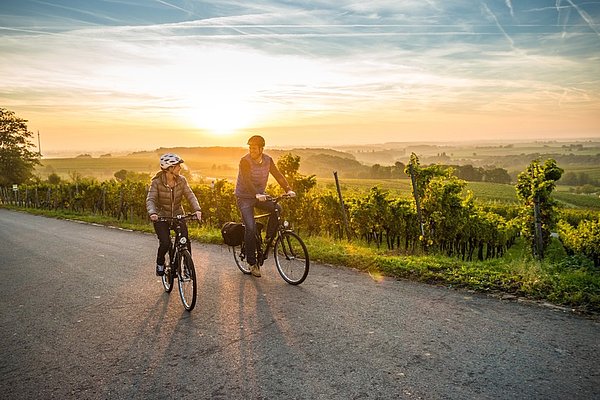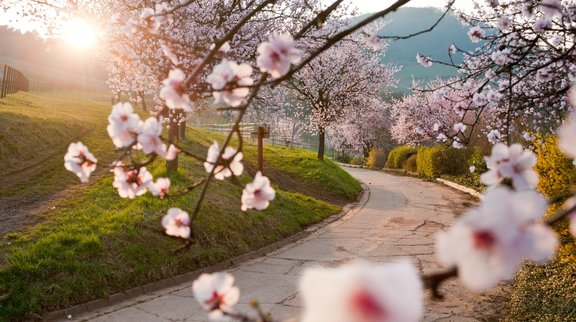

The Palatinate holiday region, located in the south of the state of Rhineland-Palatinate, comprises four holiday regions: the Palatinate Uplands with the Donnersberg in the north, the Palatinate Forest Nature Reserve in the west and the Rhine Plain in the east envelop the holiday Region of the German Wine Route.
And if this alone wasn't complicated enough, the German Wine Route holiday region is also sub-divided into two separate areas: the Central Haardt in the north and the Southern Wine Route in the south. This sub-division is ultimately politically based. The northern region consists of the district of Bad Dürkheim and the municipality of Neustadt a.d.W., and the southern region consists of the Southern Wine Route district and the municipality of Landau.

The German Wine Route is characterised by many influences: the heterogeneous landscape, the mild climate, the hospitable people, the culture of celebrating and enjoying the Palatinate.
All of this distinguishes this region, makes it what it is: a picturesque stretch of land in the south-east of the Palatinate, its charming landscape, dreamy villages and fun-loving inhabitants who radiate warmth and cordiality.
Anyone visiting the Palatinate for the first time, and especially the German Wine Route holiday region, runs the risk of becoming addicted to the region.
If you are coming from the east in the direction of Heidelberg, Mannheim or Worms, a forested mountain range dotted with castle ruins shines out at you from afar: the Haardt Mountains. As you continue your journey, you pass through vegetable fields and orchards. And then suddenly there are vines on the flat terrain to the right and left. This landscape gives you the feeling of being in a huge vineyard. In the middle: small and larger wine villages. Each place has its own charm and unmistakable character. Here you can literally feel the breath of history of past centuries. The large round-arched gates and the vines and flowers on the houses are striking. The people are also striking: they are open and warm. No matter who you talk to, a conversation quickly ensues, be it on the street, in the wine tavern or at a wine festival. Guests feel at home right away, even if the Palatinate dialect sometimes requires a little attention when listening.

Enjoyment is not neglected here either: either actively on hiking and cycling tours through the Palatinate Forest or the wine-growing landscape, or by visiting a restaurant or vintner. In addition, there is the Mediterranean-like climate, which allows many southern plants to sprout here in addition to the wine. With the multitude of wineries, grape varieties and multifaceted wines, some people have a hard time finding a favourite wine. Especially since every vintage has its own unique taste. But why should you commit yourself? Just try the wines of different Palatinate winegrowers and enjoy what you personally like. At the latest a year later, when the last vintage has been drunk, you should come back for the current vintage.



From the Rhine ...
The eastern part of the German Wine Route crosses the Rhine Plain. The country is flat here and the landscape is characterised by market gardening. There are very few hiking trails here, although this section is ideal for leisure cycling as there are very few gradients. There are a number of direct-sellers in this area and you can buy fruit and vegetables directly from the producer.
... to the wine ...
The name of the German Wine Route says it all, with wine being the dominant product in our region. It shapes the natural world, the region's culture and the people. It orders the entire country with its cross-hatched patterns.
The vineyards are generally east-facing; with the Palatinate Forest protecting them from bad weather, they soak up the sun throughout the entire year. The wine-growers can then reap the fruits of their labour in September and October. This is when there is most going on along the German Wine Route and it can often be tricky to find accommodation without booking in advance. And in the spring, at almond blossom-time, the first freshly-bottled wines can be tasted and purchased.
The topography is much more challenging here – the foothills of the Palatinate Forest can be felt particularly from north to south and the land rises and falls. Of course, it's fantastic for hiking! Gently undulating hills covered in vineyards, quaint wine-growing villages and the Palatinate Forest as a backdrop.
... to the forest
The landscape in the west of the German Wine Route is dominated by the Palatinate Forest, the largest continuous forest in Germany. Innumerable castles perched atop mountain peaks, rustic lodges serving food and drink and kilometre after kilometre of hiking trails shape this part of the Wine Route.
Hiking, mountain biking, horse-riding, trekking ... all this and so much more here. The focus is very much on hiking here. No wonder, because there are many beautiful natural sights here, historic places and lodges serving food and drink, interconnected by a dense network of hiking trails.
Would you like to explore the Palatinate Forest on one of these many hiking trails? - Not a problem!
It's simply wonderful: on the German Wine Route you feel like you're in the south. The Mediterranean-like climate allows many southern plants to flourish. The Romans brought figs, chestnuts and almonds to the region. Today, the almond blossom in spring and the Palatinate Almond Weeks are a special experience. In the 19th century, Palatinate winegrowers brought redwood trees and Mediterranean cypresses back from their travels and planted them in front of their winery villas. Today, in many a front garden you will find persimmon trees or kiwi vines alongside the usual house vine. Thanks to many hours of sunshine and mild evenings, it is especially cosy to sit on a market square or in front of one of the many restaurants, wine taverns or wine bars in the wine villages.
